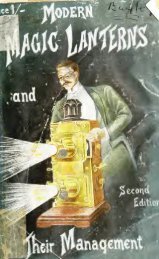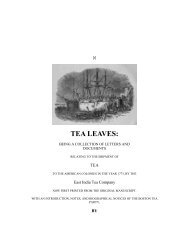The Art of projection and complete magic lantern ... - Yesterday Image
The Art of projection and complete magic lantern ... - Yesterday Image
The Art of projection and complete magic lantern ... - Yesterday Image
- No tags were found...
You also want an ePaper? Increase the reach of your titles
YUMPU automatically turns print PDFs into web optimized ePapers that Google loves.
;72In conclusion, in order to prove how safely gas may be transported inthese high-pressure bottles, I cannot do better than quote some experiments,which were made by the Scotch <strong>and</strong> Irish Oxygen Company, inMarch. 1890. <strong>The</strong>se experiments were made with a view to ascertainingthe amount <strong>of</strong> rough treatment, which a bottle would st<strong>and</strong> withoutbursting. Three bottles were all subjected to very severe treatmentthey were all <strong>of</strong> a st<strong>and</strong>ard type, viz., 5|in. external diameter by ^in.thick <strong>and</strong> lapwelded. Nos i <strong>and</strong> 2 were charged with 120 atmospheresoxygen ; No. 3 was filled with liquefied carbonic acid. No. i botUewas twice raised to a height <strong>of</strong> 35ft. <strong>and</strong> dropped horizontally upon asolid iron block 1 2 ins. square, each blow bending it to the extent <strong>of</strong>about 4 in. It was then dropped vertically on its round end having aclear fall <strong>of</strong> 31 ft. when it was found that the impact had only flatteneda part <strong>of</strong> about the size <strong>of</strong> a penny piece. It was crushed with a 15 tonblow received whilst it lay across an iron block, <strong>and</strong> it was finally bentwith the same blow whilst it was supported on two anvils set 4 ft. apart.No. 2 bottle was dropped horizontally five times from a height <strong>of</strong> 35 ft.across an anvil, receiving the blow each time on the same spot. No. 3was dropped twice 35 ft. <strong>and</strong> then crushed by a 15 ton blow. On thesebottles being subsequently tested they were found to contain the fullquantity <strong>of</strong> gas <strong>and</strong> to be perfectly sound.It it inconceivable that bottles during transit could undergo anythinglike the severe treatment to which these were subjected ; although theirvalves <strong>of</strong>ten bear testimony to the rough treatment received at the h<strong>and</strong>s<strong>of</strong> railway porters.Any latent weakness in a botUe is more likely to make itself known inthe gas compressing factory whilst it is being recharged than afterwardsin the h<strong>and</strong>s <strong>of</strong> a customer, <strong>and</strong> yet I am glad to say that althoughthous<strong>and</strong>s <strong>of</strong> these bottles now pass through our h<strong>and</strong>s every week, wehave never had an accident through the bursting <strong>of</strong> one <strong>of</strong> them in ourworks. <strong>The</strong> only two recorded accidents due to the bursting <strong>of</strong> highpressurebottles, one in Dublin, 1889, <strong>and</strong> the other in Glasgow, 1890,were proved beyond any question to be due to the spontaneous combustion<strong>of</strong> mixtures <strong>of</strong> oxygen <strong>and</strong> coal gas, <strong>and</strong> the consequent creation<strong>of</strong> a pressure inside the bottle which vastly exceeded what it wascalculated to withst<strong>and</strong>. It is in this possible mixture <strong>of</strong> gases that anelement <strong>of</strong> danger has hitherto existed in the use <strong>of</strong> high pressure bottles.It has been due mainly to the fact that insufficient precautions weretaken to avoid the possibility <strong>of</strong> bottles used for one gas being chargedwith another. <strong>The</strong> recognised rule in the trade was to paint oxygen





